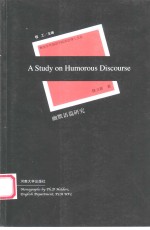
Chapter One Introduction 1
1.1 Rationale 1
1.2 Objectives 5
1.3 Research Methodology 7
1.4 The Structure of This Book 9
Chapter Two An Overview of Humor and Its Research 12
2.1 Introduction 12
2.2 Definitions of Humor 13
2.3 Nature of Humor 19
2.4 Humor-related Concepts 31
2.5 Classifications of Humor 38
2.6 Functions of Humor 42
2.7 A Brief Literature Review 46
2.8 Summary 60
Chapter Three Humorous Genres and Mismatches of Generic Structures 62
3.1 Introduction 62
3.2 Fundamental Questions on Research into Humor 63
3.3 Linguistic Humor 65
3.4 Discursive Study of Humor 68
3.5 Humorous Genres 71
3.6 Generic Structure Potential (GSP) 88
3.7 Mismatches of Generic Structures 102
3.8 Summary 115
Chapter Four Linguistic Mechanisms of Humor in Humorous Discourse 116
4.1 Introduction 116
4.2 A Brief Introduction to Linguistic Approaches to Humor 116
4.3 Language, Reality and Thinking 120
4.4 Cohesion and Coherence Features of Humorous Discourse 127
4.5 A Systemic-Functional Approach to Humorous Discourse 140
4.6 Koestler’s Dissociation Theory 149
4.7 Analyses of Two Jokes 154
4.8 Humorous Discourses beyond Humorous Genres 161
4.9 Humorous and Serious Discourse 163
4.10 Summary 165
Chapter Five The Context of Humorous Discourse and the Mismatch of Contextual Features 167
5.1 Introduction 167
5.2 The Necessity of the Contextual Dimension in Humor Research 167
5.3 The Context of Situation 171
5.4 Mismatch of Contextual Features 184
5.5 The Context of Culture 196
5.6 The Context of History 204
5.7 The Nature of the Contexts of Humorous Discourse 208
5.8 Summary 213
Chapter Six The Traits of Individual Interlocutors of Humorous Discourse 215
6.1 Introduction 215
6.2 Humor Competence 216
6.3 Personality 220
6.4 Mood 222
6.5 Intelligence 225
6.6 Gender 227
6.7 Origin or Dialect 229
6.8 Identity 232
6.9 Summary 235
Chapter Seven The Failure of Humor in Communication 236
7.1 Introduction 236
7.2 A Model of Comprehension of Linguistic Humor 237
7.3 General Causes 240
7.4 Psychology 241
7.5 Discursive Competence 244
7.6 Intertextuality 246
7.7 Sociocultural Competence 248
7.8 Other Considerations 251
7.9 Summary 254
Chapter Eight Conclusions 256
8.1 Original Findings of the Current Research 256
8.2 A Discussion of the Current Research in Relation to the General Understanding of Humor 262
8.3 Suggestions for Future Lines of Research into Humor 268
Appendices 272
Bibliography 276
后记 290
- 《红色旅游的社会效应研究》吴春焕著 2019
- 《汉语词汇知识与习得研究》邢红兵主编 2019
- 《生物质甘油共气化制氢基础研究》赵丽霞 2019
- 《东北民歌文化研究及艺术探析》(中国)杨清波 2019
- 《联吡啶基钌光敏染料的结构与性能的理论研究》李明霞 2019
- 《异质性条件下技术创新最优市场结构研究 以中国高技术产业为例》千慧雄 2019
- 《《国语》和《战国策》词汇比较研究》陈长书著 2017
- 《中国制造业绿色供应链发展研究报告》中国电子信息产业发展研究院 2019
- 《行政保留研究》门中敬著 2019
- 《新课标背景下英语教学理论与教学活动研究》应丽君 2018
- 《中风偏瘫 脑萎缩 痴呆 最新治疗原则与方法》孙作东著 2004
- 《水面舰艇编队作战运筹分析》谭安胜著 2009
- 《王蒙文集 新版 35 评点《红楼梦》 上》王蒙著 2020
- 《TED说话的力量 世界优秀演讲者的口才秘诀》(坦桑)阿卡什·P.卡里亚著 2019
- 《燕堂夜话》蒋忠和著 2019
- 《经久》静水边著 2019
- 《魔法销售台词》(美)埃尔默·惠勒著 2019
- 《微表情密码》(波)卡西亚·韦佐夫斯基,(波)帕特里克·韦佐夫斯基著 2019
- 《看书琐记与作文秘诀》鲁迅著 2019
- 《酒国》莫言著 2019
